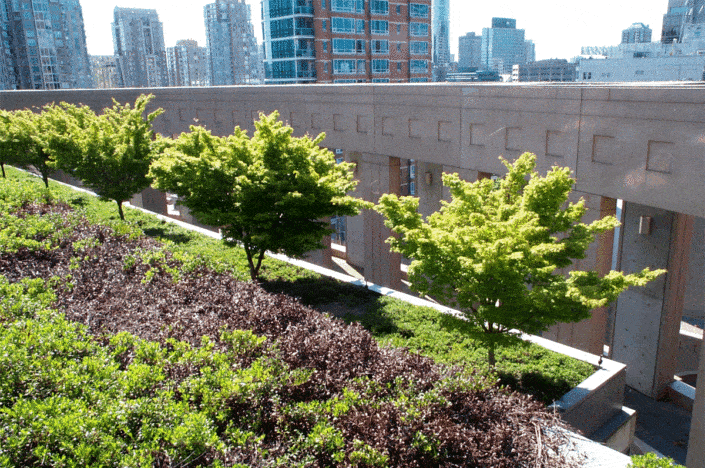Green roofs and living walls are one of the latest sustainable architecture and design trends.
These two concepts have revolutionized the way we think about urban environments,
providing a more holistic and ecological approach to making cities more livable and sustainable.
The benefits of green roofs and living walls are numerous,
from reducing energy bills to improving air quality and creating a more aesthetically pleasing outdoor environment.
Green roofs and living walls also provide many environmental benefits, such as improving air quality and reducing the urban heat island effect.
Green roofs and living walls also provide an opportunity to reduce runoff and create habitat for wildlife.
In addition, green roofs and living walls can help reduce energy bills, improve comfort in the summer,
and provide additional insulation in the winter.
Installing green roofs and living walls requires careful planning and expertise.

Where the process includes:
- Choose the right kind of green roof or living wall.
- Ensure that the structure is designed for maximum efficiency.
- Installation of the necessary materials.
There are several types of green roofs and living walls, including extensive green roofs, intense green roofs,
and hybrid green roofs, soil-based walls and hydroponic subsistence.
The cost of installing green roofs and living walls can vary greatly depending on the type of roof or wall, the size of the space,
and the complexity of the installation.
Other challenges to consider include the maintenance of the ceiling or wall,
its durability and longevity, and the availability of suitable materials and installation services.
Despite the challenges that may be involved, the benefits of installing green roofs and living walls can be significant.
Environmental benefits include improved air quality, reduced urban heat island effect,
reduced water runoff, and enhanced aesthetics.
In addition, green roofs and living walls can help increase a home’s property value.
Types of green roofs
Green roofs and living walls come in many shapes, sizes, and designs.
Green roofs and living walls can be installed differently depending on desired results and environmental elements.
· Wide green roofs
Extensive green roofs are the most common type of green roof.
These roofs are usually lightweight and low maintenance.
They are often used in large-scale environments such as commercial buildings
and large residential rooftops and can be designed to fit any size and shape.
Plants used on wide green surfaces are usually shallow rooted and require little watering and maintenance.
These plants are usually low growing and can survive with minimal watering or maintenance.
-
Intense green roofs
Intensive green roofs are the most expensive and require the most maintenance.
These roofs are often used in urban areas, usually on the roofs of small homes.
Plants used on extensive green roofs are usually larger and require more maintenance than extensive green roofs.
These plants may require regular watering and maintenance, such as pruning and fertilizing.
These plants are usually low growing and can survive with minimal watering or maintenance.
Hybrid green roofs combine elements of extensive and intense green roofs.
These surfaces are ideal for those who want a combination of low maintenance and high maintenance.

The plants used on hybrid green roofs are usually shallow-rooted, low-growing plants that can survive with minimal watering or maintenance.
However, these plants may also require regular maintenance and fertilization to keep them healthy and growing.
Green roofs and living walls are growing in popularity due to their environmental and aesthetic benefits.
An understanding of the different types of green roofs and living walls is essential for those interested in installing one,
as each type of green roof and living wall presents its own set of advantages and challenges.
Knowledge of the types of green roofs and living walls available
and the benefits and challenges associated with each type is essential for successful installation and long-term maintenance.

· Types of living walls
Living walls, also known as vertical gardens, are a type of green roof built vertically on a wall.
It can be soil-based, hydroponic, or a combination of both.
· Soil based living walls
Soil-Based Living Walls are built from soil and organic matter and are designed to be self-sustaining.
Soil is the growing medium, which gives plants the nutrients they need to thrive.
While soil-based living walls require more maintenance due to their use of soil, they also have advantages.
Soil-based living walls require less water as water is retained within the soil, reducing the need for frequent watering.
Furthermore, the soil is a natural home for beneficial insects, providing them space to thrive.
· Water living walls
Unlike soil-based living walls, aquatic living walls are built with a mixture of water and nutrients.
Nutrients are supplied to the plants through a pumping system, resulting in minimal water use.
The plants are grown in a lightweight and inert medium, such as foam or coir, allowing for easy installation.
Furthermore, hydroponic living walls require less maintenance than soil-based living walls,
as nutrients are supplied through a pump system, reducing the need for frequent watering.
· Hybrid live walls
Hybrid living walls are a combination of soil-based living walls and water-based living walls.
Hybrid living walls use a mixture of soil and an inert medium to provide the nutrients needed to plants.
The soil-based component retains water, while the hydroponics component provides nutrients through a pump system.
Hybrid live walls are also a great option for those who want to take advantage of both soil-based and water-based living walls.
Living walls can be a great addition to any home or business.
Whether a property owner is looking for environmental benefits or wants to improve the aesthetics of their property, living walls can be a great option.
The type of living wall chosen depends on various factors, including budget, space, and desired appearance.
No matter what type of living walls is chosen, they will bring life and beauty to any home or business.
For more architectural news



